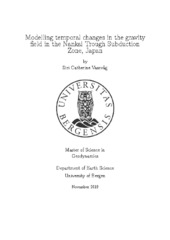Modelling temporal changes in the gravity field in the Nankai Trough Subduction Zone, Japan
Master thesis
Permanent lenke
https://hdl.handle.net/1956/21237Utgivelsesdato
2019-12-20Metadata
Vis full innførselSamlinger
- Master theses [112]
Sammendrag
The Nankai trough subduction zone off southwest Japan is prone to large earthquakes, causing tsunamis and great damages to the nearby islands. Linking the sources of these earthquakes to asperities along the plate interface is of great importance in monitoring earthquake and tsunami activity at the subduction zone. However, the location of asperities near the trough axis at the Nankai trough are not well constrained. During the interseismic period between megathrust earthquakes, shallow slow earthquakes occurring along the interface are messengers of the stress distribution outside of these asperities. They occur on areas were fluid migration on the interface leads to loosely coupled regions. Through gravity measurements, small changes in subsurface density caused by this fluid migration can be detected. These changes can be observed through time-lapse gravimetric surveys at the seafloor, allowing for detailed mapping of these gravity anomalies. In this study, forward modelling of gravity is used to estimate variations of fluid volume needed to observe temporal changes in the gravity field above the Nankai trough subduction zone. The modelled density variations are caused by changes in fluid migration along fault planes and within the pore space of rocks. Thus, the aim is to model regions where fluid migration may trigger slow earthquakes in the shallow reaches of the subduction zone. A set of slow earthquakes are used to constrain modelling locations, assuming that fluid migration within these regions will trigger these events. Through the time-lapse gravity modelling, an estimate has been made on the amount of fluid volume needed to be able to detect a gravity change at the seafloor. The modelling uses a threshold of 5 µGal for the minimum absolute gravity change, modelling variations of fluid volume within the Nankai trough accretionary prism and along the plate interface. The results are used to formulate a hypothesis on the change in fluid volume that is possible to detect at the seafloor, which can be tested through a time-lapse gravity survey on the seafloor above the accretionary prism. The results also indicate where measurement locations can be placed around the Nankai trough to obtain good precision for the measured gravity values during such a survey.
